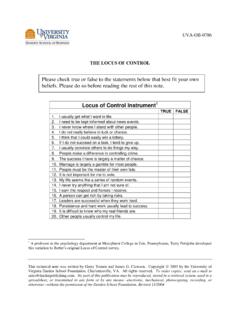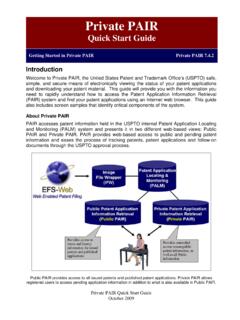Transcription of Methods of Intellectual Property Valuation
1 UVA-F-1401 This note was written by Susan Chaplinsky, Professor of Business Administration with the assistance of Graham Payne (MBA '00). Copyright 2002 by the University of Virginia Darden School Foundation, Charlottesville, VA. All rights reserved. To order copies, send an e-mail to No part of this publication may be reproduced, stored in a retrieval system, used in a spreadsheet, or transmitted in any form or by any means electronic, mechanical, photocopying, recording, or otherwise without the permission of the Darden School Foundation. Rev. 5/03 Methods of Intellectual Property Valuation This note addresses the Methods used in valuing Intellectual Property , with particular emphasis on valuing patents. Additionally, the note defines Intellectual Property and explains its growing importance in the world market.
2 Detailed descriptions of income approaches, market approaches, and a review of cost approaches can be found in the text. Defining Intellectual Property Intellectual Property (IP) shares many of the characteristics associated with real and personal Property . For example, Intellectual Property is an asset, and as such it can be bought, sold, licensed, exchanged, or gratuitously given away like any other form of Property . Further, the Intellectual Property owner has the right to prevent the unauthorized use or sale of the Property . The most noticeable difference between Intellectual Property and other forms of Property , however, is that Intellectual Property is intangible. That is, it cannot be defined or identified by its own physical parameters. Consequently, IP must be expressed in some discernible way to be protectable.
3 To be patentable, an invention must be novel, unique, useful, and nonobvious. A prerequisite to patentability is that the invention must be capable of some practical application. This emphasizes the importance the patent system puts on usefulness. One might say that a patent is a contract between society as a whole and an individual inventor. Under the terms of this social contract, the inventor is given the exclusive right to prevent others from making, using, and selling a patented invention for a fixed period of time in return for the inventor's disclosing the details of the invention to the public. Thus, patent systems encourage the disclosure of information to the public by rewarding an inventor for his or her endeavors. Under all patent systems, once this period has expired, people are free to use the invention as they wish.
4 The benefits of an effective patent system can be partially illustrated as follows: A patent rewards the investment of time, money, and effort associated with research. It stimulates further research as competitors invent alternatives to patented inventions, and it encourages innovation and investment in patented inventions by permitting companies to recover their research and development costs during the period of exclusive rights. 2 UVA-F-1401 The limited term of a patent also furthers the public interest by encouraging quick commercialization of inventions, thereby making them available to the public sooner rather than later.
5 Patents also allow for more latitude in the exchange of information between research groups, help avoid duplicative research, and, most importantly, increase the general pool of public knowledge. Intellectual Property s Increasing Importance in Corporate America Intellectual Property ? Ten years ago, that phrase wasn't even in the vocabulary of many CEOs, let alone a part of their business strategies. Indeed, many chief executives still regard patents, trademarks, copyrights, and other forms of Intellectual Property as legal matters best left to the corporate attorneys. But the burgeoning knowledge economy has given rise to a new type of CEO and a new type of business competition--one in which Intellectual Property , not fixed assets, have become the principal sources of shareholder wealth and competitive advantage.
6 The rise of the knowledge economy means that the Intellectual Property owned by a company is likely to determine its future economic success. Because Intellectual Property offers differentiation between products, it often holds the key to fast growth in market share and premium profits. Indeed, a leading product may derive its success from all seven of the major types of Intellectual Property : trade marks, design rights, copyrights, patents, know-how, confidential information for manufacture (so-called trade secrets), and finally databases ( software to manage the supply chain and targeting). Exhibit 1 lists some important innovations of the last twenty years. An analysis of the Fortune 500 companies shows that in 1975, 60 percent of their market value was represented by their tangible assets.
7 But twenty years later this percentage has fallen to just 25 percent. Since then, the proportion has fallen further and this trend looks to continue. Companies are increasingly looking to acquire undervalued and underused Intellectual Property . Indeed, the new millennium will see a new breed of corporate raiders, who strip-out and sell Intellectual Property , just as their predecessors did with undervalued tangible assets in the 1980s. In recent years, IP valuations have crept into a wide array of business situations, including: Evaluating potential merger or acquisition candidates Identifying and prioritizing assets that drive value Strengthening positions in technology transfer negotiations Making informed financial decisions on IP maintenance, commercialization and donation Evaluating the commercial prospects for early stage Research & Development (R&D) Valuing R&D efforts and prioritizing research projects Supporting a Valuation for loan collateral 3 UVA-F-1401 Thus, the quality and accuracy of IP valuations have become an important focus of senior management.
8 We turn now to a review of the Valuation techniques frequently used to value IP. Methods of Valuation Income Approach Income approaches focus on the future cash flow derived from a particular piece of IP. As with all income valuations the need to accurately forecast future cash flow is of paramount importance. The following variables are needed when using an income approach: An income stream either from product sales or licensure of the patent An estimate of the duration of the patent s useful life An understanding of patent specific risk factors and incorporating those into the Valuation A discount rate Unlike most enterprise or fixed asset valuations, Intellectual Property assets have their own set of unique risk factors. Some of these risks are: New patent Issuance: New patents can either make existing technology obsolete or, more likely, allow for another competitor in the same space.
9 If a similar patent is issued the value of the underlying technology will decrease. One key difficulty of the patent process is that it is nearly impossible to know what has been filed with the patent and Trademark Office (USPTO). Only issued patents are publicly available information and therefore the risk posed by pending patent claims cannot be easily foreseen. Exhibit 2 lists the number of new patent applications filed and granted by the USPTO from 1970 to 2001. patent Challenges/Declared Invalid: An issued patent remains open to attack for invalidity, and it is a common defense for an alleged infringer to assert that the patent is invalid. Typically, patents are challenged on the grounds that someone other than the named inventor invented the claimed Property , that the invention is obvious to persons skilled in the relevant technology, or that the patent is not unique and too similar to existing Methods .
10 Successful challenges can immediately invalidate the patent and corresponding licenses. In principle, proper due diligence should turn up these potential patent Infringement Suits: Licensees could be held liable and ultimately pay three times damages. Again, due diligence should reveal any potential problems of overlapping, uncited prior or concurrent claims. 1 Despite due diligence, it is estimated that over 43 percent of patent claims ultimately turn out to be not unique. David E. Martin, Insurable Patents? Global Metrics for Actuarial patent Risk Management, Conference on Growth, Prosperity and Patents, Danish Presidency, Aalborg, Denmark, October 28, 2002. 4 UVA-F-1401 Trade Secrets: Some patents are virtually worthless without the necessary trade secrets.













